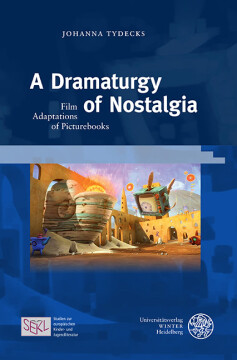
BUCH
A Dramaturgy of Nostalgia
Film Adaptations of Picturebooks
2024
Zusätzliche Informationen
Bibliografische Daten
Abstract
This monograph explores for the first time the cinematic and serial adaptation of picturebooks and picturebook Series as sources for live action films, animated films, and hybrid film productions. The interdisciplinary study, which relates to current issues in children's literature research, children's film studies, and narrative studies, addresses this trans-medial phenomenon from an interdisciplinary perspective. This complex topic, which reflects dramaturgical and formal-aesthetic aspects, focuses on questions of educational issues and the influence on various Audience groups by considering multiple media formats. These are determined by changes in social, historical, and cultural contexts, such as stereotypes in the depiction of characters, changing family roles, or the deliberate rejection of clichés. By addressing adults and children as a dual target group, the concept of nostalgia becomes key. The study is thus situated within the context of interdisciplinary memory studies, which are becoming increasingly important in media studies.
Inhaltsverzeichnis
| Zwischenüberschrift | Seite | Aktion | Preis |
|---|---|---|---|
| Cover | Cover | ||
| Title | 3 | ||
| Imprint | 4 | ||
| Dedication | 5 | ||
| Table of Contents | 7 | ||
| 1 Introduction | 11 | ||
| 1.1 Research Subject and Research Question | 11 | ||
| 1.2 State of Research | 15 | ||
| 1.2.1 Picturebook Research | 15 | ||
| 1.2.2. Adaptation Theory | 18 | ||
| 1.2.3 Research into Children’s Film | 20 | ||
| 1.3 Research Gap and Objective | 22 | ||
| 2 Theoretical Frame, Concepts and Research Structure | 25 | ||
| 2.1 Theoretical Frame | 25 | ||
| 2.1.1 Narratological Framework | 25 | ||
| 2.1.2 Media Adaptations | 31 | ||
| 2.2 Conceptual Framework | 33 | ||
| 2.2.1 Nostalgia | 33 | ||
| 2.2.2 Emotional Response and Empathy | 38 | ||
| 2.2.3 Film Dramaturgy | 41 | ||
| 2.3 Structure of the Present Study | 44 | ||
| 3 Film Adaptations of Picturebooks | 47 | ||
| 3.1. Kept plot, kept images | 47 | ||
| 3.1.1 STRUWWELPETER (FRG 1954) | 48 | ||
| 3.1.2 Early Animation: MADELINE (USA 1952) | 63 | ||
| 3.1.3 THE LOST THING (Australia 2010) | 72 | ||
| 3.1.4 Conclusion: Narrative and Dramaturgical Characteristics, Categorization | 87 | ||
| 3.2. Movies Combining Several Picturebooks into a Single Film | 90 | ||
| 3.2.1. PETTSON OCH FINDUS – KATTONAUTEN (Sweden 2000) and PETTSON OCH FINDUS – ROLIGHETER (Sweden/Germany 2014) | 92 | ||
| 3.2.2 MADELINE (USA 1998) | 112 | ||
| 3.2.3 Conclusion: Narrative and Dramaturgical Characteristics, Categorization | 119 | ||
| 3.3 Modifying the Plot (I): Movies Adding the Plot of One Picturebook | 122 | ||
| 3.3.1 THE SNOWMAN (Great Britain 1982) | 123 | ||
| 3.3.2 THE POLAR EXPRESS (USA 2004) | 133 | ||
| 3.3.3 THE THREE ROBBERS (Germany 2007) | 148 | ||
| 3.3.4 THE LORAX (USA 2012) | 158 | ||
| 3.3.5 Conclusion: Narrative and Dramaturgical Characteristics, Categorization | 172 | ||
| 3.4. Modifying the Plot (II): Movies Adding and Changing the Plot of One Picturebook | 176 | ||
| 3.4.1 WHERE THE WILD THINGS ARE (USA 2009) | 179 | ||
| 3.4.2 JUMANJI (USA 1995 and USA 2017) and ZATHURA (USA 2002) | 202 | ||
| 3.4.3 Conclusion: Narrative and Dramaturgical Characteristics, Categorization | 222 | ||
| 3.5 Modifying the Plot (III): Movies Inspired by One or Several Picturebook(s) | 226 | ||
| 3.5.1 SHREK (USA 2001) | 227 | ||
| 3.5.2 ERNEST ET CÉLESTINE (France/Belgium/Luxembourg 2012) | 248 | ||
| 3.5.3 Conclusion: Narrative and Dramaturgical Characteristics, Categorization | 268 | ||
| 4 Conclusion | 273 | ||
| 4.1 Film-aesthetic Methods of Picturebook Adaptations | 273 | ||
| 4.2 Nostalgia and Ideology | 276 | ||
| 4.3 Narrative Methods: Episodic and Ongoing Narratives | 280 | ||
| 4.4 Typology Revisited | 282 | ||
| 4.5. Outlook | 284 | ||
| 5 Bibliography | 287 | ||
| 6 List of Figures | 315 | ||
| 7 List of Films | 317 | ||
| 8 Appendix: Typological Classification of Further Picturebooks | 321 | ||
| Backcover | Backcover |


 Publishing Platform by CloudPublish
Publishing Platform by CloudPublish